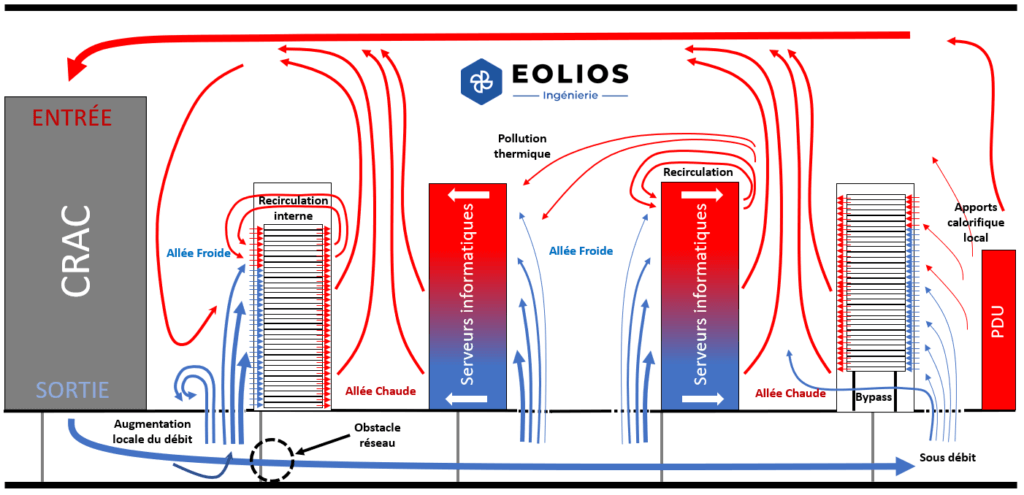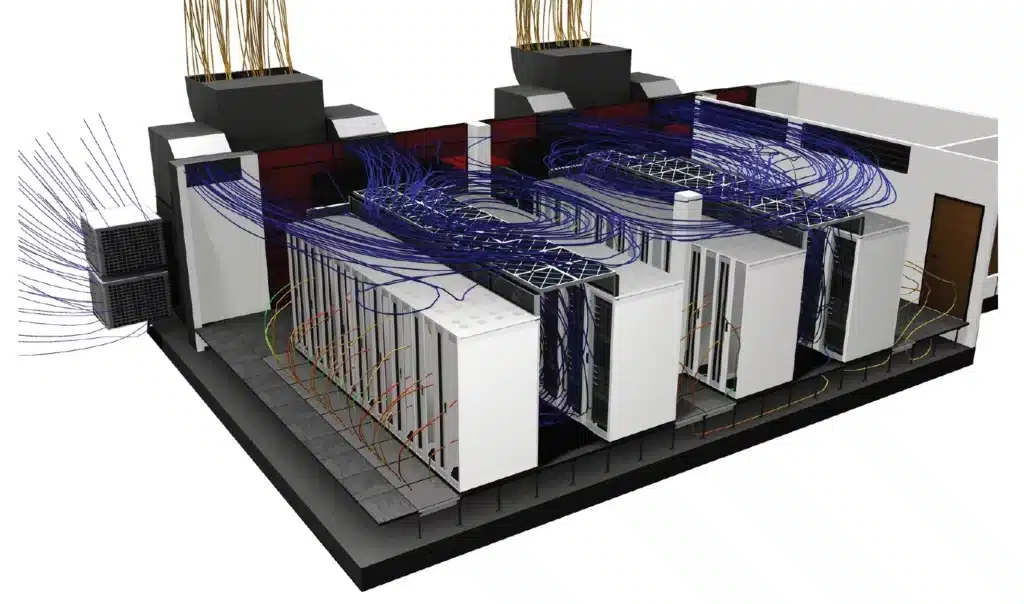CFD engineering for data centers
Home » Data Center » CFD engineering for data centers
Optimizing data center climate performance through CFD simulation
- Urbanization of hot and cold alleys
- Validation of maximum air temperature at equipment inlet
- Recommendation for chilled water temperatures
- Study of critical failure scenarios
- Identification of bypass and recirculation air flows
- Improved air distribution and cooling efficiency
- Precise dimensioning of grating layout
- Optimizing placement and control of air handling systems
- Study air handling system setpoints.
Continue navigation :
- Data center audits and diagnostics
- CFD engineering for data centers
- Thermal study of technical premises
- Generators
- Designing your data center’s digital twin
- Urban heat island impact study for data centers
- External CFD simulation for data center
- Energy optimization and PUE calculation for data centers
- Data Center Fire Simulation
- Data center audits and diagnostics
- CFD engineering for data centers
- Thermal study of technical premises
- Generators
- Designing your data center’s digital twin
- Urban heat island impact study for data centers
- External CFD simulation for data center
- Energy optimization and PUE calculation for data centers
- Data Center Fire Simulation
Our latest news :
Our projects :
Our areas of expertise :
Technical files :
How can CFD simulation be used for data centers?
Understanding the interaction between different air-conditioning systems in data centers
The CFD modeling modeling is generally used at the design stage to analyze plant sizing. Computer simulation provides information on the relationship between the operation of air conditioning systems and variations in the thermal load of IT equipment. With this information, IT and site personnel can optimize airflow efficiency and maximize cooling capacity.
Many different types of equipment and systems are installed in data centers and server rooms. An abundance of subsystems, such as rows of storage area network equipment, network switching equipment, or high-density servers, translates into an abundance of heat sources and cooling systems. Therefore, it is very difficult to understand how these different systems coexist, affecting air distribution and pressure in a room.
Our computer modeling methods, and in particular the computational fluid dynamics (CFD) tools, allow us to analyze these options in detail and to graphically represent the temperature distribution, the propagation speed of the flows and the atmospheric pressure in the different spaces
CFD modeling is not a simple solution to a problem, but a pragmatic application that can help optimize overall understanding of the project or to explore how it is possible to reduce the operating costs of an existing plant.
It also enables you to simulation to validate the climatic dimensioning of a high-density server room in an extreme scenario.
Here benefits that can be obtained from using CFD modeling in the design of a server room of a server room, or when analyzing a working data center.
- Test hypotheses on the operation of cooling systems (CRAH) in the server room
- Crisis management - Will back-up air conditioners bear the load if one of the main air conditioners fails?
- The company plans to virtualize applications; what happens if you add a new density table?
- Will the Data Center run more efficiently if IT equipment is positioned differently?
- Will the data center run more efficiently if the cooling system is changed?
- What happens if the temperature of the air entering the IT equipment rises?
- What happens if the temperature of the chilled water supplied to the CRAHs is increased?
- Is my system simply viable?
Digital twin - Data center
Our integrated study approach
Preliminary design: Study of crisis scenarios
When an EOLIOS engineer with expertise in data center design works with your team, they can solve your data center design problems. On the other hand, our mastery of the climate management of this type of space guarantees the customer a guarantee of results and the elimination of any disorders.
More importantly, by simulating crisis scenarios, unknown variables and the consequences of problems (such as supplier blackouts) can be avoided from the outset.
By using CFD modeling in the design, power and cooling systems can be optimized prior to facility construction and before investing in a project. CFD modeling allows site personnel and IT staff to validate the functionality of the systems in all crisis situations, thusavoiding the risk of malfunctioning during use.
We study safety equipment restart scenarios, loop inertia and temperature rise to calculate maximum temperatures at all points in the space and define the most unfavorable IT servers.
Digital twin - Data center
Why run a CFD simulation of a data center?
CFD modeling: an essential tool for optimal server room design
The initial investment in CFD modeling pays off many times over. The CFD model allows simple 3D images that are easy to understand by all project stakeholders, which can be analyzed by considering both static images and dynamic videos.
If necessary, information is protected, as our files can only be read on media players for which a special driver supplied by EOLIOS has been installed.
These 3D color-coded server room maps, showing heat distribution, air velocity and pressure in the space, can be used toindicate areas in need of refinement or redesign. We optimize generally optimize the positioning of floor grids in the design phase, so as to provide a homogeneous flow for all servers.
“The airflow of a false floor grille can vary by more than 50% depending on its positioning, room configuration and distance from air-conditioning systems.
Conclusions and recommendations can be made based on the information from the transient scenarios to provide a safe and reliable operating environment for your IT investment. Thus, CFD modeling services within EOLIOS are a great added value for investors and integrators, as well as for end-users, who get a clear picture of the risks their data center is facing.
Internal CFD simulation - Data center
Why run an external CFD simulation of a data center?
Define power losses under extreme conditions
Data centers are sites where the density of calorie extraction is very high. The pooling of systems, the superposition of server halls, the continuous increase in power of the server racks leads to extremely high heat dissipation on the roof. The dissipation surface being constrained by the dimensions of the building, this results in a very high concentration of air conditioning systems on the roof, leading to a significant risk of power losses, or even cascading systems failing during extreme climatic conditions.
In very hot weather, or in the event of a power cut on the site, plumes of overheated air generated by the cooling systems can lead to a sharp drop in cooling power, or even a cascading shutdown of the roof systems, resulting in a site-wide fault.
Outdoor CFD studies for data centers enable us to study the risks of power loss and optimize the layout of rooftop cooling systems.
Studies of pollution risks in premises
At the same time, it is possible to check that the exhaust fumes (Nox) from the generators are not taken up by roof-mounted AHUs, which would pollute the air in the offices.
Find out more:








